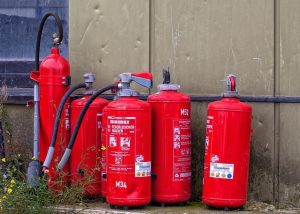 Print a Sign-In Sheet | Spanish Version
Print a Sign-In Sheet | Spanish Version
Fire Triangle:
To understand how fire extinguishers work, you need to understand a little about fire. Fire is a very rapid chemical reaction between oxygen and a combustible material, which results in the release of heat, light, flames, and smoke.
For fire to exist, the following four elements must be present at the same time:
- Enough oxygen to sustain combustion.
- Enough heat to raise the material to its ignition temperature.
- Some sort of fuel or combustible material.
- The chemical reaction that is fire.
How a Fire Extinguisher Works:
Portable fire extinguishers apply an extinguishing agent that will cool burning fuel, displace or remove oxygen, or stop the chemical reaction so a fire cannot continue to burn. When the handle of an extinguisher is compressed, agent is expelled from the nozzle.
Types and Applications: There are 4 classes of Fire Extinguishers A,B,C,D
Class A: Will put out fires in ordinary combustibles, such as wood and paper. These types of fires produce glowing embers or char. The numerical rating for this class of fire extinguisher refers to the amount of water the fire extinguisher holds and the amount of fire it will extinguish.
Class B: Should be used on fires involving flammable liquids such as grease, gasoline, oil, etc. The numerical rating for this class of fire extinguisher states the approximate number of square feet of a flammable liquid fire that a non-expert can expect to extinguish.
Class C: Are suitable for use on electrically energized fires or in materials near electrically powered equipment. This class of fire extinguisher does not have a numerical rating. The presence of the letter “C” indicates that the extinguishing agent is non-conductive.
Class D: Are designed for use on flammable metals such as magnesium, zirconium, potassium, and sodium. They are often specific for the type of metal in question. There is no picture designator for Class D extinguishers. These extinguishers generally have no rating nor are they given a multi-purpose rating for use on other types of fires.
Combination: Such as ABC or BC that will extinguish all of the types of fire in the combination. ABC extinguishers are the most common.
Location:
- Extinguishers must be conspicuous and clearly visible
- Readily accessible for immediate use without exposing employees to additional hazards
- Located along normal paths of travel and exits
- Must be unobstructed by debris
- Kept in designated locations when not being used
- Once used the extinguisher must be replaced with an alternate as soon as possible.
- Installed on hangers/brackets on the wall-not allowed on the floor
- Class A & D extinguishers-travel distance < 75 feet.
- Class B extinguishers-travel distance < 50 feet.
- Class C extinguishers–no minimum travel distance–locate in areas with electrical distribution equipment.
Inspection & Maintenance:
- A monthly visual inspection must be performed and documented by initialing the inspection tag. Conduct the inspection by checking the following items;
- Check hose and cylinder for visual damage
- Verify the security pin and zip tie are in place
- Check the pressure gauge to verify the extinguisher Is properly filled
- If any of the items above or other damage is noted, the extinguisher should be replaced with an alternate.
- An annual inspection must be performed on all extinguishers by a licensed service provider. Documentation from this inspection must be maintained on file at all times.
4 Things to know about Fire Extinguisher Usage
- Fire extinguishers are only intended to be used for fire in the initial stages. Large fires should be left for professionals.
- Only trained individuals should attempt to use a portable fire extinguisher.
- To use a portable fire extinguisher, follow the acronym P.A.S.S.
Pull the security pin.
Aim the hose at the base of the fire. Do not aim the hose at the flames.
Squeeze the handle of the fire extinguisher.
Sweep the hose back and forth until the fire is completely extinguished.*Helpful Hint (give the handle of the extinguisher a test pump to ensure you’re not too far from the fire). - When the fire extinguisher is empty, back away. Never turn your back on a fire.
KEMI does not assume liability for the content of information contained herein. Safety and health remain your responsibility. This information is to be used for informational purposes only and not intended to be exhaustive or a substitute for proper training, supervision or manufacturers’ instructions/recommendations. KEMI, by publication of this information, does not assume liability for damage or injury arising from reliance upon it. Compliance with this information is not a guarantee or warranty that you will be in conformity with any laws or regulations nor does it ensure the absolute safety of any person, place or object, including, but not limited to, you, your occupation, employees, customers or place of business.

